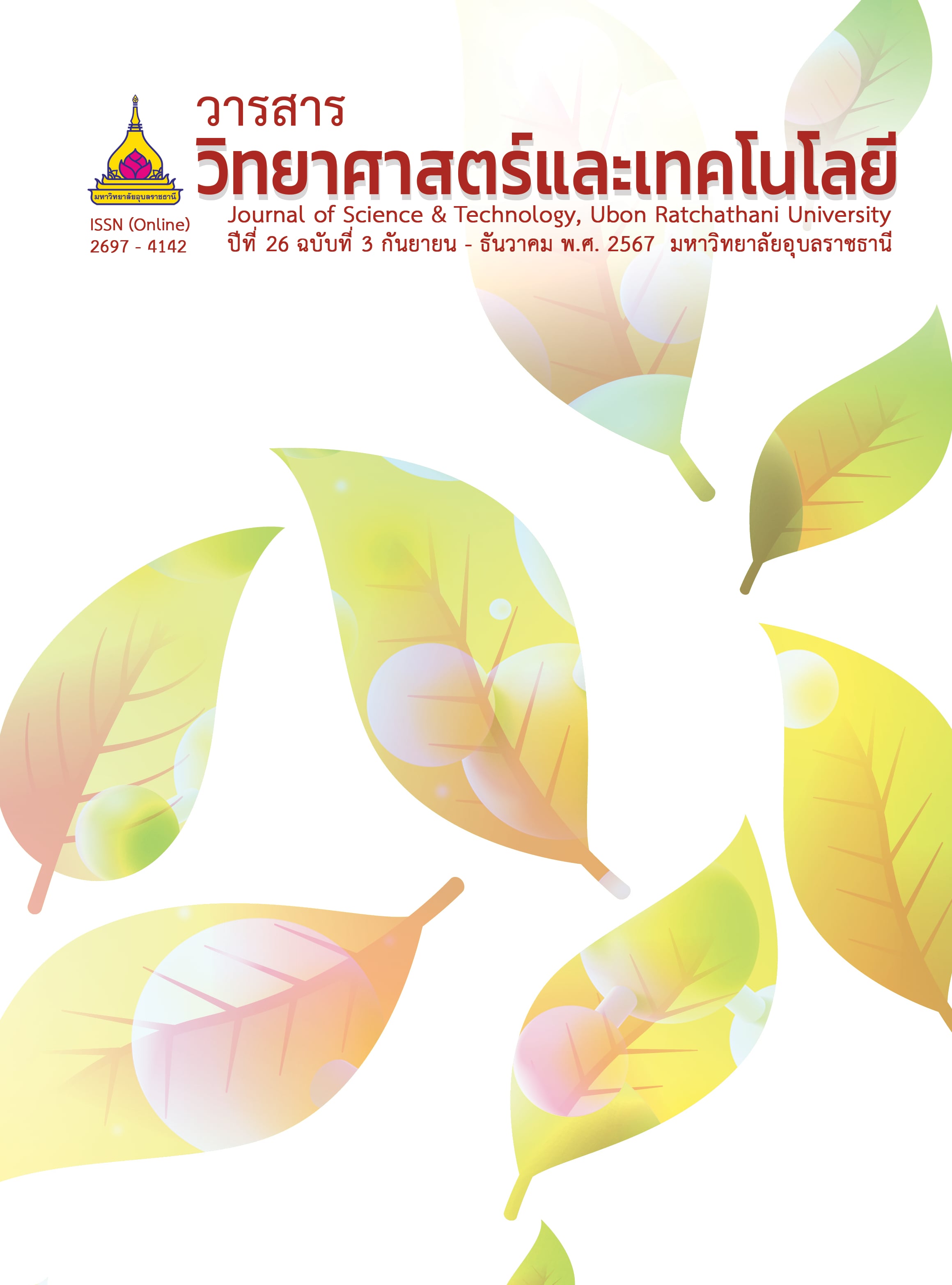ปริมาณสารประกอบฟีนอลิกรวม ปริมาณสารประกอบฟลาโวนอยด์รวม และฤทธิ์ยับยั้ง Streptococcus mutants ของสารสกัดจันทน์ทั้ง 5
Main Article Content
บทคัดย่อ
จันทน์ทั้ง 5 เป็นตำรับยาสมุนไพรไทยที่ใช้เป็นยาแก้ไข้ แก้ร้อนใน และบำรุงตับ ปอด หัวใจ ประกอบด้วยแก่นไม้สมุนไพร 5 ชนิด ได้แก่ แก่นจันทน์ทนา (Tarenna hoaensis Pit.) แก่นจันทน์แดง (Dracaena loureiroi Gagnep.) แก่นจันทน์ขาว (Santalum album) แก่นจันทน์เทศ (Myristica fragrans Houtt.) และแก่นจันทน์ชะมด (Mansonia gagei) ในปัจจุบันมีรายงานน้อยมากเกี่ยวกับฤทธิ์ของจันทน์ทั้ง 5 ในการยับยั้ง Streptococcus mutants ซึ่งเป็นเชื้อแบคทีเรียก่อโรคในช่องปาก และเป็นสาเหตุของโรคฟันผุ งานวิจัยนี้มีวัตถุประสงค์เพื่อตรวจหาปริมาณสารประกอบฟีนอลิกรวม และปริมาณสารประกอบฟลาโวนอยด์รวม รวมทั้งทดสอบฤทธิ์ยับยั้ง Streptococcus mutans ของสารสกัดเอทานอลของจันทน์ทั้ง 5 และสารสกัดเอทานอลของสมุนไพรแต่ละชนิดที่เป็นส่วนประกอบของจันทน์ทั้ง 5 ผลการทดลองแสดงให้เห็นว่าสารสกัดแก่นจันทน์แดงมีปริมาณฟีนอลิกรวมสูงสุด เท่ากับ 93.06 ± 6.67 มิลลิกรัมสมมูลของกรดแกลลิกต่อกรัมตัวอย่างแห้ง ส่วนสารสกัดแก่นจันทน์ทนามีปริมาณฟลาโวนอยด์รวมสูงสุด เท่ากับ 83.00 ± 9.84 มิลลิกรัมสมมูลของเคอร์ซิตินต่อกรัมตัวอย่างแห้ง นอกจากนี้ยังพบว่าสารสกัดแก่นจันทน์แดง แก่นจันทน์ขาว และแก่นจันทน์ทนามีฤทธิ์ยับยั้ง S. mutans ได้ดีที่สุด โดยมีค่าความเข้มข้นต่ำสุดที่สามารถยับยั้งเชื้อแบคทีเรีย (MIC) และค่าความเข้มข้นต่ำสุดที่สามารถฆ่าเชื้อแบคทีเรีย (MBC) เท่ากับ 15.62 ± 0.00 และ 31.25 ± 0.00 มิลลิกรัมต่อมิลลิลิตร ตามลำดับ ดังนั้นตำรับจันทน์ทั้ง 5 และสมุนไพร แต่ละชนิดที่เป็นส่วนประกอบของตำรับจันทน์ทั้ง 5 จึงมีศักยภาพที่จะนำไปพัฒนาต่อเพื่อใช้ในการรักษาโรคในช่องปากที่เกิดจากการติดเชื้อ S. mutans
Article Details

อนุญาตภายใต้เงื่อนไข Creative Commons Attribution-NonCommercial-NoDerivatives 4.0 International License.
บทความที่ได้รับการตีพิมพ์เป็นลิขสิทธิ์ของ วารสารวิทยาศาสตร์และเทคโนโลยี มหาวิทยาลัยอุบลราชธานี
ข้อความที่ปรากฏในบทความแต่ละเรื่องในวารสารวิชาการเล่มนี้เป็นความคิดเห็นส่วนตัวของผู้เขียนแต่ละท่านไม่เกี่ยวข้องกับมหาวิทยาลัยอุบลราชธานี และคณาจารย์ท่านอื่นๆในมหาวิทยาลัยฯ แต่อย่างใด ความรับผิดชอบองค์ประกอบทั้งหมดของบทความแต่ละเรื่องเป็นของผู้เขียนแต่ละท่าน หากมีความผิดพลาดใดๆ ผู้เขียนแต่ละท่านจะรับผิดชอบบทความของตนเองแต่ผู้เดียว
เอกสารอ้างอิง
Bowen, W.H. and Koo, H.J.C.R. 2011. Biology of Streptococcus mutans-derived glucosyltransferases: Role in extracellular matrix formation of cariogenic biofilms. Caries Research. 45(1): 69-86.
Loesche, W. 2007. Dental caries and periodontitis: Contrasting two infections that have medical implications. Infectious Disease Clinics of North America. 21(2): 471-502.
Attin, T. and et al. 2003. Review of the current status of tooth whitening with the walking bleach technique. International Endodontic Journal. 36(5): 313-329.
Lata, S. and et al. 2010. A deep UBVRI CCD photometry of six open star clusters in the galactic anticenter region. The Astronomical Journal. 139(2): 378.
Palombo, E.A. 2011. Traditional medicinal plant extracts and natural products with activity against oral bacteria: Potential application in the prevention and treatment of oral diseases. Evidence-based complementary and Alternative Medicine. 2011: 680354.
Sun, J. and et al. 2019. Phenolic constituents, pharmacological activities, quality control, and metabolism of Dracaena species: A review. Journal of Ethnopharmacology. 244: 112138.
Ohn-on, W. and et al. 2022. Effects of extraction methods on total phenolic content and antioxidant activity of Chan-Tang-Ha recipe. Journal of Science and Technology, Ubon Ratchathani University. 24(3): 88-96. (in Thai)
Dechayont, B. and et al. 2021. Antibacterial, anti-inflammatory and antioxidant activities of Mahanintangtong and its constituent herbs, a formula used in Thai traditional medicine for treating pharyngitis. BMC Complementary Medicine and Therapies. 21(1): 105.
Kacharin, H. and et al. 2021. Antioxidant and anti-inflammatory activities of water extracted Jan Tung Ha. In: Proceedings of the 52nd National Graduate Research Conference, 28 May 2021. Chonburi, Thailand. (in Thai)
Oyedemi, T.O. and et al. 2014. Effect of Myristica fragrans Houtt. Seed (Nutmeg) on Helicobacter pylori induced gastritis in albino rats: in vitro and in vivo studies. International Journal of Biological and Chemical Sciences. 8(4): 1355-1367.
Reanmongkol, W., Subhadhirasakul, S. and Bouking, P. 2003. Antinociceptive and antipyretic activities of extracts and fractions from Dracaena loureiri in experimental animals. Songklanakarin Journal of Science and Technology. 25(4): 467-476.
Meda, A. and et al. 2005. Determination of the total phenolic, flavonoid and proline contents in Burkina Fasan honey, as well as their radical scavenging activity. Food chemistry. 91(3): 571-577.
Hemeg, H.A. and et al. 2020. Antimicrobial effect of different herbal plant extracts against different microbial population. Saudi Journal of Biological Sciences. 27(12): 3221-3227.
Andrews, J.M. 2001. Determination of minimum inhibitory concentrations. Journal of Antimicrobial Chemotherapy. 48(1): 5-16.
Chung, J.Y. and et al. 2006. Anticariogenic activity of macelignan isolated from Myristica fragrans (nutmeg) against Streptococcus mutans. Phytomedicine. 13(4): 261-266.
Sendamangalam, V. and et al. 2011. Antimicrobial and antioxidant activities of polyphenols against Streptococcus mutans. Free Radicals and Antioxidants. 1(3): 48-55.
Yan, L. and et al. 2023. Anti-biofilm and bacteriostatic effects of three flavonoid compounds on Streptococcus mutans. Biofouling. 39(3): 245-256.
Pumpaluk, P. and et al. 2017. Antibacterial effect of herbal plants against three cariogenic microorganisms. Mahidol Dental Journal. 37(1): 71-80.


